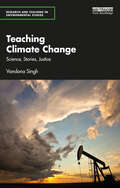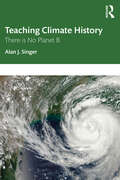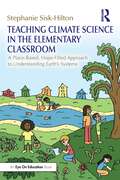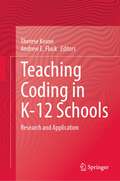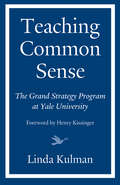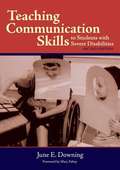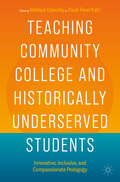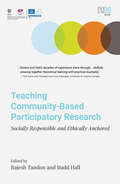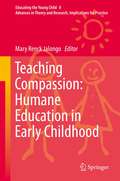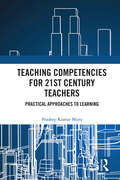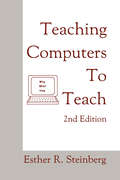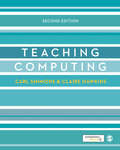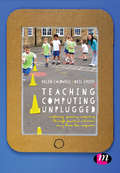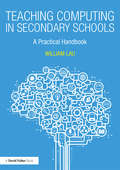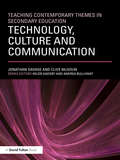- Table View
- List View
Teaching Climate Change: Science, Stories, Justice (Research and Teaching in Environmental Studies)
by Vandana SinghTeaching Climate Change: Science, Stories, Justice shows educators how climate change can be taught from any disciplinary perspective and in a transdisciplinary way, drawing on examples from the author's own classroom. The book sets out a radical vision for climate pedagogy, introducing an innovative framework in which the scientific essentials of climate change are scaffolded via three transdisciplinary meta-concepts: Balance/Imbalance, Critical Thresholds and Complex Interconnections. Author Vandana Singh grounds this theory in practice, drawing on examples from her own classroom to provide implementable ideas for educators, and to demonstrate how climate change can be taught from any disciplinary perspective in a transdisciplinary way. The book also explores the barriers to effective climate education at a macro level, focusing on issues such as climate misinformation/misconception, the exclusion of social and ethical concerns and a focus on technofixes. Singh uses this information to identify four key dimensions for an effective climate pedagogy, in which issues of justice are central: scientific-technological, the transdisciplinary, the epistemological and the psychosocial. This approach is broad and flexible enough to be adapted to different classrooms and contexts. Bridging the social and natural sciences, this book will be an essential resource for all climate change educators practicing in both formal and informal settings, as well as for community climate activists.
Teaching Climate History: There is No Planet B
by Alan J. SingerWelcome to the Anthropocene. Since the start of the Industrial Revolution, human-caused climate change has impacted the globe with the burning of fossil fuels. The debate in classrooms and the political realm should not be whether climate change is happening or how much it places human civilization at risk but over how societies and individuals should respond. This interdisciplinary book offers an in-depth examination of the history of the Earth’s climate and how historians and citizens can influence contemporary climate debate and activism. The author explains climate history and climate science and makes this important subject matter accessible to a general audience. Chapter topics include examining the Earth’s geological past, the impact of climate on human evolution, the impact of climate on earlier civilizations, climate activism, and the need for international cooperation. Presenting climate history, human history, and climate science in a readable format and featuring resources for students, this book is meant for use by teachers in high school elective or an introductory college course setting.
Teaching Climate Science in the Elementary Classroom: A Place-Based, Hope-Filled Approach to Understanding Earth’s Systems
by Stephanie Sisk-HiltonDiscover new ways to help elementary students engage with and understand the world around them through place-based, hope-filled learning about the causes, impacts, and responses to climate change. This book features foundational climate concepts, easily implementable activity plans, and inspiring examples of student engagement. Each chapter begins with a short vignette pulled from the author’s considerable teaching experience in engaging students in concepts of climate change and climate justice, followed by content-focused sections and recommendations for student activities and projects. The author provides stories of hope-filled action to invite teachers to look for and reflect on similar narratives in their own communities. Sample units of study for grades K-5 show teachers how key ideas from each chapter come together into an instructional plan that incorporates the three dimensions of NGSS and can fit into the broader outline of their school year. This resource is an accessible tool to support any elementary educator in building their own knowledge base and integrating the important and timely issues of climate change into their classroom.
Teaching Coding in K-12 Schools: Research and Application
by Therese Keane Andrew E. FluckThis book contains highly effective ways to teach coding and computational thinking skills throughout primary and secondary schooling. It outlines a research informed path for students from birth to 18 years, identifying key skills and learning activities. Based on global perspectives and research at each stage, it outlines how these findings can be applied in the classroom. Teaching coding to students in K-12 has been a skillset that has been debated across educational jurisdictions globally for some time. The book provides examples of schools that are teaching coding to students in engaging and relevant ways, delivering well thought out compulsory curriculums. Additionally, it provides examples of schools where coding is not mandated in the curriculum and is taught in an ad-hoc manner. Through the full discussion of all of these varied examples, the book presents both sides of the serious and ongoing debate in the field as to whether coding should be taught in an explicit way at all. The increasing school of thought that teaching coding is a skill that is already obsolete, and the focus should be on computational thinking is completely examined and presented. In this book, both sides of the argument, as well as the specific, meticulous research underlying each side, are given equal weight. The debate is a serious one and requires a clearly defined thematic response with evidence on all sides of the argument presented rationally. This book does just that. Created by carefully selected authors from around the world, it will be a highly studied research reference.
Teaching College-Level Disciplinary Literacy: Strategies and Practices in STEM and Professional Studies
by Juanita C. ButThis volume foregrounds the disciplinary literacy approach to college teaching and learning with in-depth discussions of theory and research, as well as extensive classroom illustrations. Built upon the current work of READ (Reading Effectively Across the Disciplines), a disciplinary literacy program at New York City College of Technology, it presents a broad collection of methodologies, strategies, and best practices with discipline-specific considerations. It offers an overview of the program informed by evidence-based research and practices in college disciplinary learning, describing how its unique model addresses the literacy needs of students in STEM and professional studies. Chapter authors, including administrators, literacy specialists, and content experts discuss program design, professional development, and assessments. They also outline strategies to foster disciplinary literacy pedagogy and college success in five content areas, including Accounting, Architecture, Biology, Electromechanical Engineering, and Mathematics.
Teaching College: The Ultimate Guide to Lecturing, Presenting, and Engaging Students
by Norman EngYour students aren't reading. They aren't engaged in class. Getting them to talk is like pulling teeth. Whatever the situation, your reality is not meeting your expectations. Change is needed. But who's got the time? Or maybe you're just starting out, and you want to get it right the first time. If so, Teaching College: The Ultimate Guide to Lecturing, Presenting, and Engaging Students is the blueprint. Written for early career instructors, this easy-to-implement guide teaches you to: -Think like advertisers to understand your target audience-your students -Adopt the active learning approach of the best K-12 teachers -Write a syllabus that gets noticed and read -Develop lessons that stimulate deep engagement -Create slide presentations that students can digest -Get students to do the readings, participate more, and care about your course Secrets like "focusing on students, not content" and building a "customer" profile of the class will change the way you teach. The author, Dr. Norman Eng, argues that much of these approaches and techniques have been effectively used in marketing and K-12 education, two industries that could greatly improve how college instructors teach. Find out how to hack the world of college classrooms and have your course become the standard by which all other courses will be measured against. Whether you are an adjunct, a lecturer, an assistant professor, or even a graduate assistant, pedagogical success is within your grasp.
Teaching Comedy (Options for Teaching)
From Shakespeare to The Simpsons, comedy has long provided both entertainment and social commentary. It may critique cultural values, undermine authority, satirize sacred beliefs, and make room for the marginalized to approach the center. Comedy can be challenging to teach, but in the classroom it can help students connect with one another, develop critical thinking skills, and engage with important issues.The essays in this volume address a rich variety of texts spanning film, television, stand-up, cartoons, and memes as well as conventional literary works from different places and times. Contributors offer theoretical foundations and practical methods for a broad range of courses, including guidance on contextualizing the humor of historical works and on navigating the ways that comedy can both subvert and reinforce stereotypes. Finally, the volume argues for the value of comedy in difficult times, as a way to create community and meaning.This volume contains discussion of fiction, poetry, plays, and essays by Maya Angelou, Jane Austen, Aphra Behn, Hugh Henry Brackenridge, Frances Burney, Charles W. Chesnutt, Roddy Doyle, Maria Edgeworth, Ben Jonson, Anita Loos, Emtithal Mahmoud, Thomas Middleton, Okot p'Bitek, William Shakespeare, Laurence Sterne, Jonathan Swift, Alma Villanueva, Paula Vogel, Oscar Wilde, John Wilmot, and William Wycherley; TV shows and films including Crazy Ex-Girlfriend, The Gold Rush, Life Is Beautiful, The Marvelous Mrs. Maisel, The Office, Office Space, Rick and Morty, and South Park; works and stand-up performances by Aziz Ansari, Samantha Bee, Dave Chappelle, Louis C.K., Tina Fey, Moms Mabley, Hasan Minhaj, Eddie Murphy, Trevor Noah, Richard Pryor, Issa Rae, and Wanda Sykes; and visual works and other media including Aaron McGruder's The Boondocks, Bill Watterson's Calvin and Hobbes, Nick Sousanis's Unflattening, Marvel's Hawkeye, The Onion, YouTube videos, advertisements, and memes.
Teaching Comics Through Multiple Lenses: Critical Perspectives
by Crag HillBuilding off the argument that comics succeed as literature—rich, complex narratives filled with compelling characters interrogating the thought-provoking issues of our time—this book argues that comics are an expressive medium whose moves (structural and aesthetic) may be shared by literature, the visual arts, and film, but beyond this are a unique art form possessing qualities these other mediums do not. Drawing from a range of current comics scholarship demonstrating this point, this book explores the unique intelligence/s of comics and how they expand the ways readers engage with the world in ways different than prose, or film, or other visual arts. Written by teachers and scholars of comics for instructors, this book bridges research and pedagogy, providing instructors with models of critical readings around a variety of comics.
Teaching Common Sense: The Grand Strategy Program at Yale University
by Linda KulmanHow is critical thinking taught? How will the next generation cope with an ever-changing and increasingly complex world? These are questions that the Grand Strategy program at Yale seeks to address. The Brady-Johnson Program in Grand Strategy seeks to revive the study and practice of grand strategy by devising methods to teach that subject at the graduate and undergraduate levels, by training future leaders to think about and implement grand strategies in imaginative and effective ways, and by organizing public events that emphasize the importance of grand strategy. The program defines "grand strategy” as a comprehensive plan of action, based on the calculated relationship of means to large ends. Never an exact science, grand strategy requires constant reassessment and adjustment. Flexibility is key. Traditionally believed to belong to and best-developed in the politico-military and governmental realms, the concept of grand strategy applies--and ISS believes is essential--to a broad spectrum of human activities, not least those of international institutions, non-governmental organizations, and private businesses and corporations. For fifteen years, the Grand Strategy program has been cultivating leadership skills of undergraduates and graduate students of Yale University. In Linda Kulman’s compelling book, we learn about this remarkable program from the inside, sharing the stress of the "murder boards,” the revelation of applying the classics to current geopolitical situations, and the crucial importance of fast decision-making under duress. Teaching Common Sense weaves together on-site reporting, archival research, and original survey data into an intellectual history of the Grand Strategy program.
Teaching Communication Skills to Students with Severe Disabilities
by June E. DowningLearners with severe disabilities frequently encounter two problems: they have difficulty in the classroom giving and receiving responses appropriate to their needs, and they are confronted by instructors and aides whose insufficient expertise and discomfort causes negative classroom experiences for all involved. Writing for both in-service and pre-service teachers, Downing (special education, California State U., Northridge) provides strategies they can use to develop confidence in their skills as assessors of communication skills and needs and providers of instruction geared toward the needs of learners. She and her contributors give systematic advice about preparing a good learning environment, teaching in an inclusive classroom, meeting students where they are in their communication, and working in teams to bridge gaps in knowledge and experience. Annotation ©2005 Book News, Inc., Portland, OR (booknews.com)
Teaching Communication, Skills and Competencies for the International Workplace: A Resource for Teachers of English
by Julio GimenezBacked by evidence and research, this practical book presents an innovative yet comprehensive approach to teaching non-native English speakers the main communication and cultural competencies that are required to succeed in an international English-speaking workplace. Each unit includes strategies for teaching key skills, tasks to encourage reflection and notes on relevant cultural and technological issues. Practical features in each unit include lesson plans and materials, insights from research, extension tasks, reflection activities and further readings. Supported by current learning theories, key teaching methodologies and assessment materials, the chapters address the challenges that non-native English speakers may face in the international English-speaking workplace. Areas of focus include: Job hunting Job applications Interviews Interpersonal, written and spoken communication Performance appraisals Applying for promotions Written for pre-service, practicing and future teachers, with specific guidance for each role, this is an essential resource for all educators who want to confidently address the challenges that non-English speakers may encounter at work, including linguistic proficiency, cultural awareness and the use of technology.
Teaching Communication: Theory, Research, and Methods
by Gustav W. Friedrich Anita L. Vangelisti John A. DalyThe field of communication was founded, in part, because of a need to make people better communicators. That meant teaching them how to communicate more effectively, whether it be in public settings or in private. Most of that teaching has happened within the classroom and many professionals have spent their lives instructing others on various aspects of communication. Inside this second edition, the editors have assembled a fully comprehensive and contemporary discussion of topics and issues concerning the teaching of communication. The chapters contained herein--contributed by key voices throughout the communication discipline--address conceptual as well as practical issues related to communication instruction. The contents of this new edition reflect the dramatic changes that have occurred in communication education since the publication of the first edition in 1990. This book focuses initially on the goals of communication education, then delves into the preparation of specific communication courses. It includes assistance for instructors in organizing instructional content and discusses the use of instructional strategies and tools, as well as offering ideas on evaluating the processes and products of instruction. The volume also covers unique teaching assignments that may be encountered, from the basic course to continuing education, and addresses 2-year college teaching, directing forensic programs, distance education, and consulting. It concludes with important professional issues faced by both new and experienced communication instructors, including ethics and political issues within classrooms and departments. This volume is a necessity for anyone starting out a career as a communication instructor. Veteran educators--who know that learning to teach is a continual growth experience--will find useful and invaluable information within the book's pages. Whatever background and level of experience, all communication educators will find this new edition to be an essential resource for their work.
Teaching Community College and Historically Underserved Students: Innovative, Inclusive, and Compassionate Pedagogy
by Zivah Perel Katz Melissa DennihyThis textbook develops and presents a new hybrid pedagogy that integrates the best practices of both face-to-face and online teaching within community colleges and other access-oriented institutions. Focusing specifically on historically underserved students, this text demonstrates how online pedagogy offers new and different approaches to learning, engaging, collaborating, and communicating which can also be adapted for face-to-face classrooms, creating an innovative blended pedagogy that builds upon both course experiences. Recognizing that higher education is at a unique turning point as the Covid-19 pandemic and its effects become endemic, this volume offers educators ways to forge new paths forward and prepare for future crises by learning how to maximize the possibilities of both face-to-face and online learning tools and approaches.
Teaching Community-Based Participatory Research: Socially Responsible and Ethically Anchored
by Budd Hall Rajesh TandonSpearheaded by Drs Tandon and Hall, this book emerges from the Mentor Training Program (MTP) linked to the UNESCO Chair in Community-Based Research, reflecting over fifty years of dedicated work in participatory research.With 170 mentors trained and a reach of 15,000 students worldwide, the MTP exemplifies a commitment to fostering socially responsible research practices. This essential resource equips educators to navigate complex power dynamics, address ethical considerations, and integrate innovative, arts-based methods into community-based participatory research (CBPR) teaching.A transformative guide that delves into the principles and practices of CBPR, it features insights from mentors across diverse global contexts. This book offers practical strategies for embedding CBPR principles into academic curricula, becoming a vital toolkit for researchers, educators, and activists eager to co-create impactful knowledge that addresses the most pressing challenges of today.
Teaching Compassion - Humane Education in Early Childhood
by Mary Renck JalongoIn response to highly publicized incidents of school violence, educators across the United States and in many other nations are seeking effective ways to prevent and modify aggressive and anti-social behaviors in students. One of the major recommendations of the research is that efforts to prevent cruelty need to begin early, during the early childhood years of birth through age eight. The focus of Teaching Compassion: Humane Education in Early Childhood is guiding young children to accept responsibility for and to be kind in their interactions with fellow human beings, animals and the environment. Although humane education is a relatively new concept in the field of early childhood education, professionals in the field are very familiar with many of the related concepts, including: promoting positive interpersonal interactions, teaching children the skills of self-regulation, giving children experience in caring for living things and protecting the environment. This edited volume is an interdisciplinary compendium of professional wisdom gathered from experts in the fields of education, child development, science, psychology, sociology and humane organizations. As the book amply documents, the concept of humane education is powerful, integrative, timely and appropriate in work with young children. Teaching Compassion: Humane Education in Early Childhood shows how it is possible for adults dedicated to the care and education of young children to balance attention to the cognitive and affective realms and, in so doing, to elevate the overall quality of early childhood programs for children, families and communities.
Teaching Competencies for 21st Century Teachers: Practical Approaches to Learning
by Pradeep Kumar MisraA must-read for every teacher in the 21st Century, this book provides a comprehensive guide to facilitating joyful, sustainable, holistic, multidisciplinary, and active learning. The book discusses different approaches, principles, techniques, and activities for creating a classroom where different learning types can thrive. The methods outlined in this volume help teachers ensure that every learner, regardless of background or orientation, can engage in participatory, reflective, self-directed, experiential, entrepreneurial, and collaborative learning and develop holistically. Essential for the 21st century, the book highlights the significance of digital technologies and examines how teachers can easily use digital technologies to offer personalized and blended learning. This book is a vital resource for teachers who want to improve their teaching skills and create a positive and engaging learning environment for their learners. This book helps teachers across the globe to enhance learning outcomes in classrooms and, subsequently, develop the quality of their education systems. This volume is useful to students, researchers, and teachers in education, psychology, development studies, social work, and sociology. It is also an invaluable companion to policymakers and professionals from government and non-government organisations working in the education and social development sectors.
Teaching Computational Thinking and Coding in Primary Schools (Transforming Primary QTS Series)
by David Wells David Morris Gurmit UppalThis is a guide to the teaching of computing and coding in primary schools, and an exploration of how children develop their computational thinking. It covers all areas of the National Curriculum for primary computing and offers insight into effective teaching. The text considers three strands of computer science, digital literacy and information technology. The teaching of coding is especially challenging for primary teachers, so it highlights learning on this, giving practical examples of how this can be taught. For all areas of the computing curriculum the text also provides guidance on planning age-appropriate activities with step-by-step guides and details of educationally appropriate software and hardware. This book helps you to connect what you need to teach with how it can be taught, and opens up opportunities in the new curriculum for creative and imaginative teaching. It also includes the full National Curriculum Programme of Study for Computing, key stages 1 and 2 as a useful reference for trainee teachers.
Teaching Computational Thinking: An Integrative Approach for Middle and High School Learning
by Lisa Dion Maureen D. NeumannA guide for educators to incorporate computational thinking—a set of cognitive skills applied to problem solving—into a broad range of subjects.Computational thinking—a set of mental and cognitive tools applied to problem solving—is a fundamental skill that all of us (and not just computer scientists) draw on. Educators have found that computational thinking enhances learning across a range of subjects and reinforces students&’ abilities in reading, writing, and arithmetic. This book offers a guide for incorporating computational thinking into middle school and high school classrooms, presenting a series of activities, projects, and tasks that employ a range of pedagogical practices and cross a variety of content areas. As students problem solve, communicate, persevere, work as a team, and learn from mistakes, they develop a concrete understanding of the abstract principles used in computer science to create code and other digital artifacts. The book guides students and teachers to integrate computer programming with visual art and geometry, generating abstract expressionist–style images; construct topological graphs that represent the relationships between characters in such literary works as Harry Potter and the Sorcerer&’s Stone and Romeo and Juliet; apply Newtonian physics to the creation of computer games; and locate, analyze, and present empirical data relevant to social and political issues. Finally, the book lists a variety of classroom resources, including the programming languages Scratch (free to all) and Codesters (free to teachers). An accompanying website contains the executable programs used in the book&’s activities.
Teaching Computers To Teach
by Esther R. SteinbergLike the original version of Teaching Computers to Teach, this updated edition presents procedures and principles for designing computer-presented instruction. It was written as a result of recent developments in three domains that have significant implications for computer-assisted instruction (CAI) and computer-based training (CBT). These areas are audio and videodisc technology, CAI and CBT experience, and research in the processes of learning. This practical book is written specifically for people who want to learn to design CAI. The book presents a CAI-specific design procedure by integrating knowledge about unique aspects of human-machine interaction with theories of learning and instruction as well as practical experience with CAI. The reader is guided through the entire design process, from initial planning to final evaluation, by clearcut principles and concrete examples.
Teaching Computing (Developing as a Reflective Secondary Teacher)
by Mrs Claire Hawkins Carl SimmonsPreviously known as Teaching ICT, this second edition has been carefully revised to meet the new demands of computer science as a curriculum subject. With a clear focus on the theory and practice that supports high quality teaching, this textbook provides pragmatic guidance on how to plan, teach, manage and assess computer science teaching. Key coverage includes: · An awareness of the requirements of the 2014 National Curriculum for England · Developing computational thinking and digital literacy in your classroom · Pedagogy for teaching computer programming · Computer science in primary schools and the transition to secondary This is essential reading for secondary computer science student teachers and for those on primary initial teacher education courses seeking a greater understanding of the subject, including school-based (SCITT, School Direct, Teach First), university-based (PGCE, PGDE, BEd, BA QTS) and employment-based routes into teaching, and current teachers updating their practice. Carl Simmons and Claire Hawkins are Senior Lecturers at Edge Hill University.
Teaching Computing (Developing as a Reflective Secondary Teacher)
by Carl Simmons Claire HawkinsPreviously known as Teaching ICT, this second edition has been carefully revised to meet the new demands of computer science as a curriculum subject. With a clear focus on the theory and practice that supports high quality teaching, this textbook provides pragmatic guidance on how to plan, teach, manage and assess computer science teaching. Key coverage includes: · An awareness of the requirements of the 2014 National Curriculum for England · Developing computational thinking and digital literacy in your classroom · Pedagogy for teaching computer programming · Computer science in primary schools and the transition to secondary This is essential reading for secondary computer science student teachers and for those on primary initial teacher education courses seeking a greater understanding of the subject, including school-based (SCITT, School Direct, Teach First), university-based (PGCE, PGDE, BEd, BA QTS) and employment-based routes into teaching, and current teachers updating their practice. Carl Simmons and Claire Hawkins are Senior Lecturers at Edge Hill University.
Teaching Computing Unplugged in Primary Schools: Exploring primary computing through practical activities away from the computer
by Neil Smith Helen CaldwellTeaching primary computing without computers? The Computing curriculum is a challenge for primary school teachers. The realities of primary school resources mean limited access to computer hardware. But computing is about more than computers. Important aspects of the fundamental principles and concepts of computer science can be taught without any hardware. Children can learn to analyse problems and computational terms and apply computational thinking to solve problems without turning on a computer. This book shows you how you can teach computing through ‘unplugged’ activities. It provides lesson examples and everyday activities to help teachers and pupils explore computing concepts in a concrete way, accelerating their understanding and grasp of key ideas such as abstraction, logic, algorithms and data representation. The unplugged approach is physical and collaborative, using kinaesthetic learning to help make computing concepts more meaningful and memorable. This book will help you to elevate your teaching, and your children′s learning of computing beyond the available hardware. It focuses on the building blocks of understanding required for computation thinking.
Teaching Computing Unplugged in Primary Schools: Exploring primary computing through practical activities away from the computer
by Neil Smith Ms Helen CaldwellTeaching primary computing without computers? The Computing curriculum is a challenge for primary school teachers. The realities of primary school resources mean limited access to computer hardware. But computing is about more than computers. Important aspects of the fundamental principles and concepts of computer science can be taught without any hardware. Children can learn to analyse problems and computational terms and apply computational thinking to solve problems without turning on a computer. This book shows you how you can teach computing through ‘unplugged’ activities. It provides lesson examples and everyday activities to help teachers and pupils explore computing concepts in a concrete way, accelerating their understanding and grasp of key ideas such as abstraction, logic, algorithms and data representation. The unplugged approach is physical and collaborative, using kinaesthetic learning to help make computing concepts more meaningful and memorable. This book will help you to elevate your teaching, and your children's learning of computing beyond the available hardware. It focuses on the building blocks of understanding required for computation thinking.
Teaching Computing in Secondary Schools: A Practical Handbook
by William LauThis book provides a step-by-step guide to teaching computing at secondary level. It offers an entire framework for planning and delivering the curriculum and shows you how to create a supportive environment for students in which all can enjoy computing. The focus throughout is on giving students the opportunity to think, program, build and create with confidence and imagination, transforming them from users to creators of technology. In each chapter, detailed research and teaching theory is combined with resources to aid the practitioner, including case studies, planning templates and schemes of work that can be easily adapted. The book is split into three key parts: planning, delivery, and leadership and management, and covers topics such as: curriculum and assessment design lesson planning cognitive science behind learning computing pedagogy and instructional principles mastery learning in computing how to develop students’ computational thinking supporting students with special educational needs and disabilities encouraging more girls to study computing actions, habits and routines of effective computing teachers behaviour management and developing a strong classroom culture how to support and lead members of your team. Teaching Computing in Secondary Schools is essential reading for trainee and practising teachers, and will prove to be an invaluable resource in helping teaching professionals ensure that students acquire a wide range of computing skills which will support them in whatever career they choose.
Teaching Contemporary Themes in Secondary Education: Technology, Culture and Communication
by Jonathan Savage Clive McGounThe media has a huge impact on how we view society and the world, and new technologies continue to transform the way in which we work and learn. It is therefore essential that young people can engage critically in their consumption of media and the internet and are able to make informed decisions about the technologies they use. This book explores the broad contexts and ideas that technology facilitates in our culture and considers what this means for teachers in practice. It aims to help you develop your understanding about, and pedagogy with, technology and includes: the implications of new media and technology on twenty-first century education; guidance on choosing and using digital technologies and how these affect the educational opportunities for young people; a consideration of students’ critical and creative thinking with digital media and their confidence and autonomy in digital consumption and production; references to recent research to support practice; Links to resources and organisations who can offer support. Technology has a crucial role to play in processes of teaching and learning. This book is essential reading for trainee and practising teachers that wish to use a range of technological tools to form a dynamic and creative learning environment.
